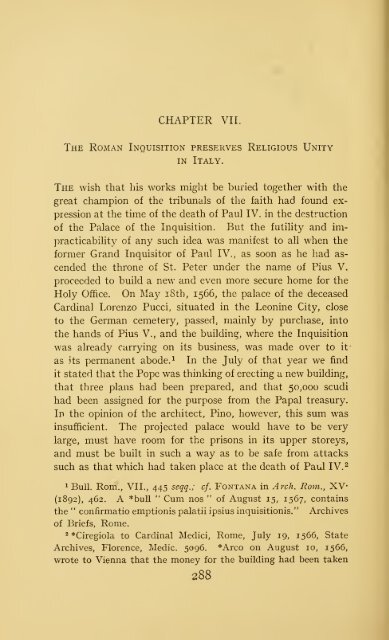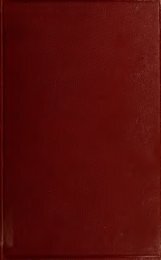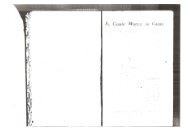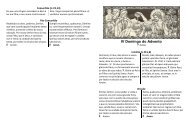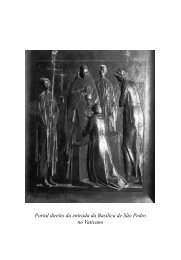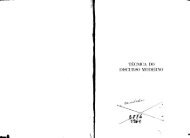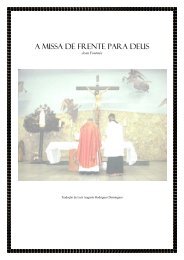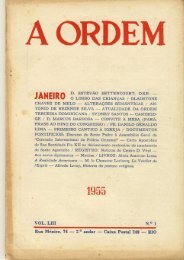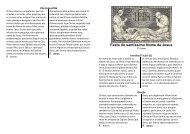- Page 2 and 3:
6". (. . a^. LIBRARY OF THE THEOLOG
- Page 5 and 6:
HISTORY OF THE POPES VOL. XVII
- Page 7 and 8:
^^b- -.«x 'viAy 1929 THE ^\0Glca3t
- Page 9:
CONTENTS OF VOLUME XVII. Collection
- Page 12 and 13:
viii ARCHIVES & MANUSCRIPTS IN VOLS
- Page 14 and 15:
X COMPLETE TITLES OF BOOKS Balan, P
- Page 16 and 17:
xii COMPLETE TITLES OF BOOKS Cambri
- Page 18 and 19:
xiv COMPLETE TITLES OF BOOKS Dierau
- Page 20 and 21:
xvi COMPLETE TITLES OF BOOKS Gothei
- Page 22 and 23:
Xviii COMPLETE TITLES OF BOOKS Lago
- Page 24 and 25:
XX COMPLETE TITLES OF BOOKS Mutinel
- Page 26 and 27:
Xxii COMPLETE TITLES OF BOOKS Renaz
- Page 28 and 29:
xxiv COMPLETE TITLES OF BOOKS Stein
- Page 30 and 31:
TABLE OF CONTENTS OF VOLUME XVlI. A
- Page 32 and 33:
XXVlll TABLE OF CONTENTS. Pius V. a
- Page 34 and 35:
XXX TABLE OF CONTENTS. A.D. CHAPTER
- Page 36 and 37:
xxxu TABLE OF CONTENTS. A.D. CHAPTE
- Page 38 and 39:
LIST OF UNPUBLISHED DOCUMENTS IN AP
- Page 40 and 41:
XXXvi POPE PIUS XI TO BARON VON PAS
- Page 42 and 43:
2 HISTORY OF THE POPES. In order to
- Page 44 and 45:
4 HISTORY OF THE POPES. Caligari sa
- Page 46 and 47:
6 HISTORY OF THE POPES. 1565, Hfgh
- Page 48 and 49:
8 HISTORY OF THE POPES. Cardinals h
- Page 50 and 51:
10 HISTORY OF THE POPES. intended t
- Page 52 and 53:
12 HISTORY OF THE POPES. if Spanish
- Page 54 and 55:
14 HISTORY OF THE POPES. indeed he
- Page 56 and 57:
l6 HISTORY OF THE POPES. though he
- Page 58 and 59:
l8 HISTORY OF THE POPES. Ferrara.i
- Page 60 and 61:
20 HISTORY OF THE POPES. want of un
- Page 62 and 63:
22 HISTORY OF THE POPES. tine party
- Page 64 and 65:
24 HISTORY OF THE POPES. from Franc
- Page 66 and 67:
26 HISTORY OF THE POPES. declared t
- Page 68 and 69:
28 HISTORY OF THE POPES. worked lik
- Page 70 and 71:
30 HISTORY OF THE POPES. followers
- Page 72 and 73:
32 HISTORY OF THE POPES. the rumour
- Page 74 and 75:
34 HISTORY OF THE POPES. to satisfy
- Page 76 and 77:
36 HISTORY OF THE POPES. But Farnes
- Page 78 and 79:
38 HISTORY OF THE POPES. Papacy, sa
- Page 80 and 81:
40 HISTORY OF THE POPES. Chapel. At
- Page 82 and 83:
42 HISTORY OF THE POPES. Ghislieri
- Page 84 and 85:
44 HISTORY OF THE POPES. for the ri
- Page 86 and 87:
CHAPTER II. Previous Life and Chara
- Page 88 and 89:
48 HISTORY OF THE POPES. provincial
- Page 90 and 91:
50 HISTORY OF THE POPES, titular ch
- Page 92 and 93:
52 HISTORY OF THE POPES. had, so to
- Page 94 and 95:
54 HISTORY OF THE POPES. as bishop
- Page 96 and 97:
56 HISTORY OF THE POPES. unwell,^ t
- Page 98 and 99:
58 HISTORY OF THE POPES. of abstine
- Page 100 and 101:
6o HISTORY OF THE POPES. which he c
- Page 102 and 103:
62 HISTORY OF THE POPES. what a dee
- Page 104 and 105:
64 HISTORY OF THE POPES. flattered
- Page 106 and 107:
66 HISTORY OF THE POPES. because he
- Page 108 and 109:
68 HISTORY OF THE POPES. out the de
- Page 110 and 111:
70 HISTORY OF THE POPES. Prince of
- Page 112 and 113:
72 HISTORY OF THE POPES. at the Pap
- Page 114 and 115:
74 HISTORY OF THE POPES. authority,
- Page 116 and 117:
y6 HISTORY OF THE POPES. found hims
- Page 118 and 119:
yS HISTORY OF THE POPES. by the Pop
- Page 120 and 121:
8o HISTORY OF THE POPES. the rights
- Page 122 and 123:
82 HISTORY OF THE POPES. in politic
- Page 124 and 125:
84 HISTORY OF THE POPES. His other
- Page 126 and 127:
86 HISTORY OF THE POPES The Romans
- Page 128 and 129:
88 HISTORY OF THE POPES. as murdere
- Page 130 and 131:
go HISTORY OF THE POPES. tried to p
- Page 132 and 133:
92 HISTORY OF THE POPES. How deep s
- Page 134 and 135:
94 HISTORY OF THE POPES. life.^ One
- Page 136 and 137:
96 HISTORY OF THE POPES. other thin
- Page 138 and 139:
CHAPTER III Government of the State
- Page 140 and 141:
100 HISTORY OF THE POPES. prudence,
- Page 142 and 143:
102 HISTORY OF THE POPES. Another r
- Page 144 and 145:
104 HISTORY OF THE POPES. Rome and
- Page 146 and 147:
I06 HISTORY OF THE POPES. thing whi
- Page 148 and 149:
I08 HISTORY OF THE POPES. of cloth.
- Page 150 and 151:
no HISTORY OF THE POPES. Unfortunat
- Page 152 and 153:
112 HISTORY OF THE POPES. senate an
- Page 154 and 155:
114 HISTORY OF THE POPES. there, a
- Page 156 and 157:
Il6 HISTORY OF THE POPES. of the ti
- Page 158 and 159:
Il8 HISTORY OF THE POPES. adjoining
- Page 160 and 161:
120 HISTORY OF THE POPES. pupil of
- Page 162 and 163:
122 HISTORY OF THE POPES. tion of a
- Page 164 and 165:
124 HISTORY OF THE POPES. his own t
- Page 166 and 167:
126 HISTORY OF THE POPES. soon made
- Page 168 and 169:
128 HISTORY OF THE POPES. Pius V. a
- Page 170 and 171:
130 HISTORY OF THE POPES. year afte
- Page 172 and 173:
132 HISTORY OF THE POPES. Rome in 1
- Page 174 and 175:
134 HISTORY OF THE POPES. however,
- Page 176 and 177:
CHAPTER IV. Reforming Zeal of Pius
- Page 178 and 179:
138 HISTORY OF THE POPES. In all hi
- Page 180 and 181:
140 HISTORY OF THE POPES. Following
- Page 182 and 183:
142 HISTORY OF THE POPES. shepherd
- Page 184 and 185:
144 HISTORY OF THE POPES. all the d
- Page 186 and 187:
146 HISTORY OF THE POPES. Bonelli,
- Page 188 and 189:
148 HISTORY OF THE POPES. presented
- Page 190 and 191:
150 HISTORY OF THE POPES. a way tha
- Page 192 and 193:
152 HISTORY OF THE POPES. In other
- Page 194 and 195:
154 HISTORY OF THE POPES. to which
- Page 196 and 197:
156 HISTORY OF THE POPES. An additi
- Page 198 and 199:
158 HISTORY OF THE POPES. maturely
- Page 200 and 201:
l60 HISTORY OF THE POPES. happy the
- Page 202 and 203:
l62 HISTORY OF THE POPES. difficult
- Page 204 and 205:
164 HISTORY OF THE POPES. the cardi
- Page 206 and 207:
l66 HISTORY OF THE POPES. forty, an
- Page 208 and 209:
l68 HISTORY OF THE POPES. tion of t
- Page 210 and 211:
170 HISTORY OF THE POPES. Council,
- Page 212 and 213:
172 HISTORY OF THE POPES. been dism
- Page 214 and 215:
174 HISTORY OF THE POPES. sidered h
- Page 216 and 217:
176 HISTORY OF THE POPES. the gener
- Page 218 and 219:
178 HISTORY OF THE POPES. The colle
- Page 220 and 221:
l80 HISTORY OF THE POPES. ascertain
- Page 222 and 223:
l82 HISTORY OF THE POPES, Cardinal/
- Page 224 and 225:
184 HISTORY OF THE POPES. lege, acc
- Page 226 and 227:
l86 HISTORY OF THE POPES. comply wi
- Page 228 and 229:
l88 HISTORY OF THE POPES. questrati
- Page 230 and 231:
IQO HISTORY OF THE POPES. the Pope'
- Page 232 and 233:
CHAPTER V. Reform of the Church on
- Page 234 and 235:
194 HISTORY OF THE POPES. The year
- Page 236 and 237:
196 HISTORY OF THE POPES. Christian
- Page 238 and 239:
198 HISTORY OF THE POPES. The bring
- Page 240 and 241:
200 HISTORY OF THE POPES. In this w
- Page 242 and 243:
202 HISTORY OF THE POPES. the line
- Page 244 and 245:
204 HISTORY OF THE POPES. that of t
- Page 246 and 247:
206 HISTORY OF THE POPES. matters d
- Page 248 and 249:
208 HISTORY OF THE POPES. mounted o
- Page 250 and 251:
210 HISTORY OF THE POPES. which ena
- Page 252 and 253:
212 HISTORY OF THE POPES. and chapt
- Page 254 and 255:
214 HISTORY OF THE POPES. the Bisho
- Page 256 and 257:
2l6 HISTORY OF THE POPES. most impo
- Page 258 and 259:
2l8 HISTORY OF THE POPES. This pers
- Page 260 and 261:
220 HISTORY OF THE POPES. of Italy.
- Page 262 and 263:
222 HISTORY OF THE POPES. had shown
- Page 264 and 265:
224 HISTORY OF THE POPES. where her
- Page 266 and 267:
226 HISTORY OF THE POPES. and other
- Page 268 and 269:
228 HISTORY OF THE POPES. Confrater
- Page 270 and 271:
230 HISTORY OF THE POPES. to demand
- Page 272 and 273:
232 HISTORY OF THE POPES. ^ of ever
- Page 274 and 275:
234 HISTORY OF THE POPES. were ambi
- Page 276 and 277:
236 HISTORY OF THE POPES. It was do
- Page 278 and 279: 238 HISTORY OF THE POPES. of a nobl
- Page 280 and 281: CHAPTER VI, The Reform of the Relig
- Page 282 and 283: 242 HISTORY OF THE POPES. eleven ce
- Page 284 and 285: 244 HISTORY OF THE POPES. of God, h
- Page 286 and 287: 246 Cremona ; HISTORY OF THE POPES.
- Page 288 and 289: 248 HISTORY OF THE POPES. made over
- Page 290 and 291: 250 HISTORY OF THE POPES. the Corte
- Page 292 and 293: 252 HISTORY OF THE POPES. scattered
- Page 294 and 295: 254 HISTORY OF THE POPES. Premonstr
- Page 296 and 297: 256 HISTORY OF THE POPES. of King S
- Page 298 and 299: 258 HISTORY OF THE POPES. met with,
- Page 300 and 301: 26o HISTORY OF THE POPES. rich bene
- Page 302 and 303: 262 HISTORY OF THE POPES. of religi
- Page 304 and 305: 264 HISTORY OF THE POPES. holiest m
- Page 306 and 307: 266 HISTORY OF THE POPES. it withou
- Page 308 and 309: 268 HISTORY OF THE POPES. of Pius I
- Page 310 and 311: 270 HISTORY OF THE POPES. rights.^
- Page 312 and 313: 272 HISTORY OF THE POPES. The great
- Page 314 and 315: 274 HISTORY OF THE POPES. election
- Page 316 and 317: , time 276 HISTORY OF THE POPES. fo
- Page 318 and 319: 278 HISTORY OF THE POPES. three sol
- Page 320 and 321: 280 HISTORY OF THE POPES. with comp
- Page 322 and 323: 282 HISTORY OF THE POPES. things ha
- Page 324 and 325: 284 HISTORY OF THE POPES. went to t
- Page 326 and 327: 286 HISTORY OF THE POPES. of the Ch
- Page 330 and 331: 290 HISTORY OF THE POPES. had taken
- Page 332 and 333: 292 HISTORY OF THE POPES. PYom the
- Page 334 and 335: 294 HISTORY OF THE POPES. of June 6
- Page 336 and 337: 296 HISTORY OF THE POPES. governor
- Page 338 and 339: 298 HISTORY OF THE POPES. true reme
- Page 340 and 341: 300 HISTORY OF THE POPES. guise of
- Page 342 and 343: 302 HISTORY OF THE POPES. Even grea
- Page 344 and 345: 304 HISTORY OF THE POPES. ous heret
- Page 346 and 347: 306 HISTORY OF THE POPES. to the se
- Page 348 and 349: 308 HISTORY OF THE POPES. the relig
- Page 350 and 351: 310 HISTORY OF THE POPES. formal er
- Page 352 and 353: 312 HISTORY OF THE POPES. mentioned
- Page 354 and 355: 314 HISTORY OF THE POPES. names 115
- Page 356 and 357: 3l6 HISTORY OF THE POPES. Inquisito
- Page 358 and 359: 3l8 HISTORY OF THE POPES. to the sp
- Page 360 and 361: 320 HISTORY OF THE POPES. to preven
- Page 362 and 363: 322 HISTORY OF THE POPES. ambassado
- Page 364 and 365: 324 HISTORY OF THE POPES. at the be
- Page 366 and 367: o 26 HISTORY OF THE POPES. suppress
- Page 368 and 369: 328 HISTORY OF THE POPES. themselve
- Page 370 and 371: 330 HISTORY OF THE POPES. The edict
- Page 372 and 373: 332 HISTORY OF THE POPES. no fear o
- Page 374 and 375: 334 HISTORY OF THE POPES. A bull of
- Page 376 and 377: 336 HISTORY OF THE POPES. laws as t
- Page 378 and 379:
338 HISTORY OF THE POPES. convinced
- Page 380 and 381:
340 HISTORY OF THE POPES. August 15
- Page 382 and 383:
342 HISTORY OF THE POPES. The sermo
- Page 384 and 385:
CHAPTER VIII. The Trial of the Arch
- Page 386 and 387:
346 HISTORY OF THE POPES. and Felic
- Page 388 and 389:
348 HISTORY OF THE POPES. that a st
- Page 390 and 391:
350 HISTORY OF THE POPES. were tend
- Page 392 and 393:
352 HISTORY OF THE POPES. but that
- Page 394 and 395:
354 HISTORY OF THE POPES. the dread
- Page 396 and 397:
356 HISTORY OF THE POPES. must be s
- Page 398 and 399:
358 HISTORY OF THE POPES. and above
- Page 400 and 401:
360 HISTORY OF THE POPES. mission,
- Page 402 and 403:
362 HISTORY OF THE POPES. In severa
- Page 404 and 405:
364 HISTORY OF THE POPES. told him
- Page 406 and 407:
366 HISTORY OF THE POPES. Catherine
- Page 408 and 409:
368 HISTORY OF THE POPES. of Sacred
- Page 410 and 411:
370 HISTORY OF THE POPES. universit
- Page 412 and 413:
372 HISTORY OF THE POPES. Hessels o
- Page 414 and 415:
374 HISTORY OF THE POPES. their opi
- Page 416 and 417:
376 HISTORY OF THE POPES. 1568, Mor
- Page 418 and 419:
378 HISTORY OF THE POPES. Morillon
- Page 420 and 421:
380 HISTORY OF THE POPES. submissio
- Page 422 and 423:
382 HISTORY OF THE POPES. countryme
- Page 424 and 425:
384 HISTORY OF THE POPES. ducebatur
- Page 426 and 427:
386 HISTORY OF THE POPES. deret ; i
- Page 428 and 429:
300 HISTORY OF THE POPES. per noi,
- Page 430 and 431:
390 HISTORY OF THE POPES. Don Anton
- Page 432 and 433:
392 HISTORY OF THE POPES. 5. NICCOL
- Page 434 and 435:
394 HISTOKY OF THE POPES. et sin ho
- Page 436 and 437:
30 HISTORY OF THE POPES. 4. Avviso
- Page 438 and 439:
398 HISTORY OF THE POPES. 8. Awiso
- Page 440 and 441:
400 April 14 : HISTORY OF THE POPES
- Page 442 and 443:
402 HISTORY OF THE POPES. [1567] Di
- Page 444 and 445:
404 HISTORY OF THE POPES. fuit ince
- Page 446 and 447:
406 HISTORY OF THE POPES. fessionem
- Page 448 and 449:
4o8 HISTORY OF THE POPES. August 13
- Page 450 and 451:
410 HISTORY OF THE POPES. hopes of
- Page 452 and 453:
412 HISTORY OF THR POPES. tradendis
- Page 454:
414 HISTORY OF THE POPES. With the
- Page 457 and 458:
APPENDIX. 417 p. 141 : Minute of th
- Page 459 and 460:
APPENDIX. 419 se aliquod habere exi
- Page 461 and 462:
APPENDIX. 421 printed,^ and later o
- Page 463 and 464:
APPENDIX. 423 account given by Cate
- Page 465 and 466:
APPENDIX. 425 8. Kurtzer Entimirff
- Page 467 and 468:
INDEX OF NAMES IN VOL. XVII. Adrian
- Page 469 and 470:
Buccia, Doctor (court-jester of Piu
- Page 471 and 472:
Este, Ippolito d', Cardinal. 2 seq.
- Page 473 and 474:
La Baurae, Claude de (Archbp. of Be
- Page 475 and 476:
Panvinio, Onofrio, 52 n. i, 131, 20
- Page 477 and 478:
Scappi, Bartolomeo (cook to Pius v.
- Page 482 and 483:
DATE DUE


